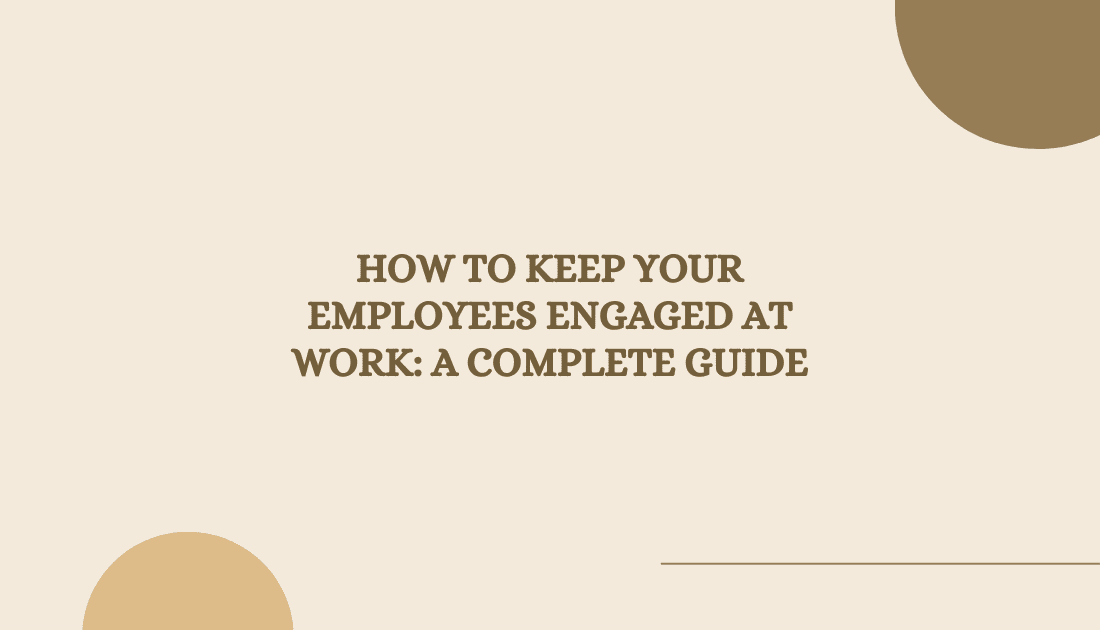In the quest for success, employee engagement stands tall as a game-changer, wielding the power to transform productivity, fuel loyalty, and uplift the collective spirit. As a leader, the responsibility falls upon your shoulders to craft an environment that ignites passion by learning how to keep employees engaged.
A surefire strategy to achieve this? Embrace the transformative force of employee development, and watch engagement soar to new heights.
And today, you’re in luck because this article will tell you everything about how to keep employees engaged. Keeping employee engagement high is essential for any successful business and doesn’t have to be complicated or time-consuming.
We’ll explore the need for employee engagement and discuss some tips on how to keep employees engaged, motivated, and productive. So let’s get started!
What is Employee Engagement?
Employee engagement plays a significant role in shaping a thriving work environment. It refers to employees’ level of involvement, enthusiasm, and commitment toward their work and the workplace. Organizations can assess and enhance various aspects of their culture and practices to foster a more positive and productive workforce by knowing how to keep employees engaged.
As defined by Gallup, employee engagement encompasses the active participation and enthusiasm employees demonstrate toward their work and the organization they work for. It goes beyond job satisfaction and reflects employees’ emotional connection and dedication to their roles and the workplace.
Reasons You Should Know How to Keep Employees Engaged
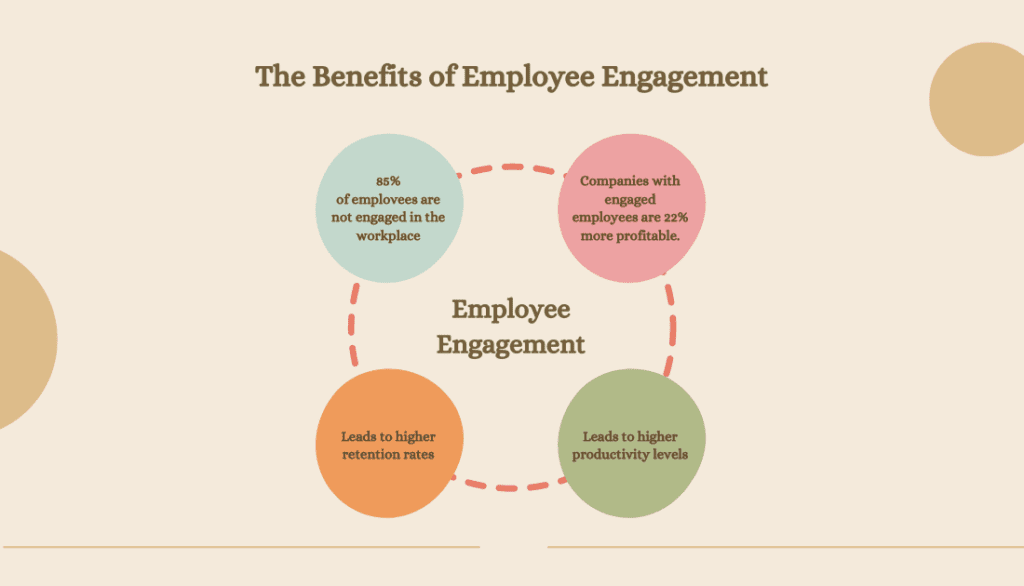
Here are the benefits of employee engagement, which will, hopefully, motivate you to learn how to keep employees engaged:
- Increased Productivity: Engaged employees are more motivated, focused, and committed, resulting in higher levels of productivity and efficiency within the organization.
- Improved Employee Retention: When employees are engaged, they are more likely to stay with the company for the long term, reducing turnover costs and maintaining a stable workforce.
- Enhanced Customer Satisfaction: Engaged employees go the extra mile to provide exceptional customer service, leading to higher customer satisfaction and increased loyalty.
- Innovation and Creativity: Engaged employees feel empowered to contribute their ideas and insights, fostering a culture of innovation and creativity within the organization.
- Stronger Team Collaboration: Engaged employees are more willing to collaborate and work together, improving teamwork, communication, and problem-solving capabilities.
- Positive Organizational Culture: Employee engagement creates a positive and supportive work environment, boosting morale, and promoting a sense of belonging, leading to higher employee morale and overall satisfaction.
Employee engagement is a critical factor in building a motivated and committed workforce. Organizations can foster a culture that supports positive business outcomes, employee satisfaction, and long-term success by prioritizing employee engagement.
How To Keep Employees Engaged? Strategies for Increasing Employee Engagement
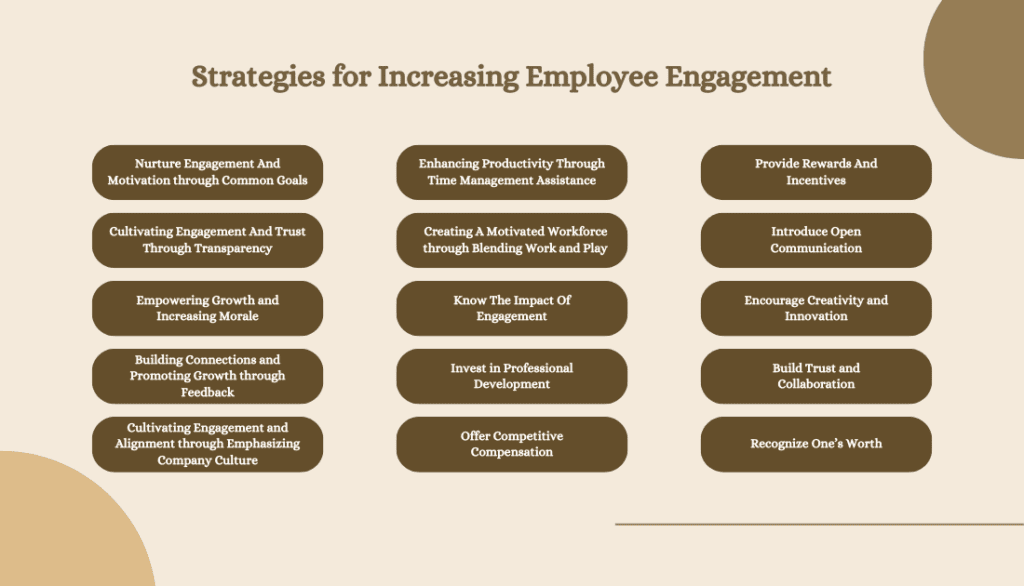



Employee engagement plays a crucial role in the success of any business. It enhances performance and fosters a deeper connection between employees and their work. Hence, here are the top strategies to keep your teammates and employees engaged.
Employee engagement is crucial for maintaining a motivated and productive workforce. By setting common goals, promoting transparency, seeking feedback, emphasizing workplace culture, and supporting time management, employers can create an engaged work environment that benefits both the employees and the organization.
Nurture Engagement And Motivation through Common Goals
Setting common goals that align with the organization’s aspirations can profoundly impact employee engagement and motivation. By establishing attainable and challenging objectives, individuals are encouraged to strive for excellence continuously.
When employees share a common goal, it fosters a sense of camaraderie within the team, instilling a stronger investment in their work and a deep understanding of the significance of collaboration for achieving success.
Furthermore, this connection between individual efforts and the organization’s mission generates heightened engagement and motivation among all team members. Effective communication and dissemination of the shared goal are crucial in sustaining high levels of engagement throughout the workplace.
Cultivating Engagement And Trust Through Transparency
Being transparent with your team significantly fosters a stronger bond and drives collective progress toward the company’s mission. By openly communicating about the organization’s goals and the path to success, a deeper connection is formed among team members.
Transparency in communication nurtures trust between employees and leadership, enabling them to collaborate more effectively. Moreover, it empowers employees by instilling a sense of ownership over their work, increasing motivation and engagement.
To promote transparency, leaders should establish clear expectations for tasks, explain decisions, be accessible for questions and concerns, foster social interactions among coworkers, and appropriately handle confidential information.
Empowering Growth and Increasing Morale
By embracing transparency, organizations create opportunities for employee growth and significantly improve overall morale. This approach cultivates employee engagement, a vital factor for the success of any business.
It helps build strong relationships between the company and its workforce and boosts productivity and performance. Transparency is pivotal in fostering meaningful connections between employers and employees.
Constituting is essential to creating an effective work environment that allows teams to unlock their full potential.
Building Connections and Promoting Growth through Feedback
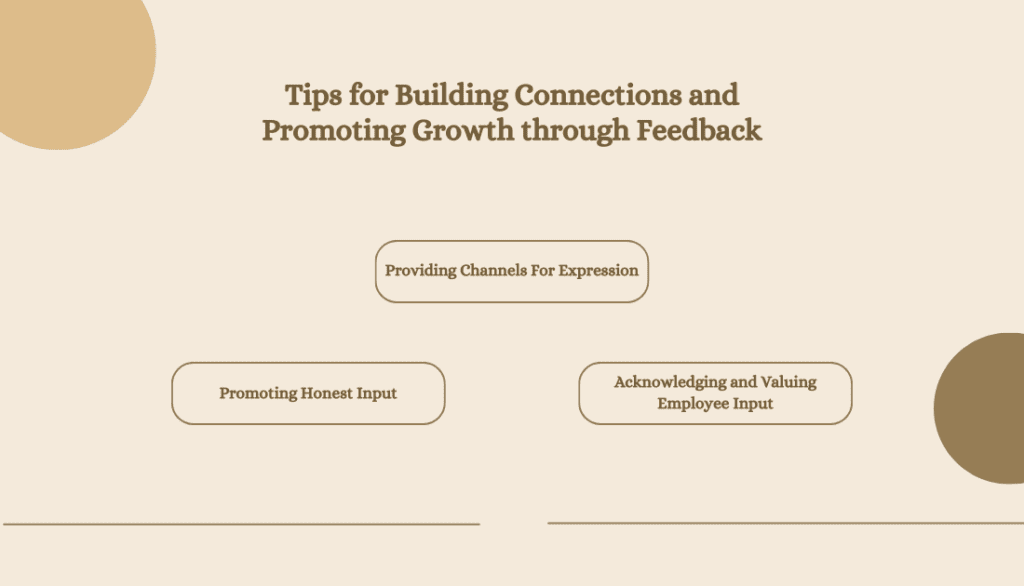



Seeking feedback from your staff plays a key role in establishing meaningful connections and ensuring that every voice is heard. Creating an environment where employees feel comfortable expressing their honest opinions helps in understanding areas of high engagement and identifies opportunities for professional development.
To actively encourage feedback, consider the following tips:
Providing Channels For Expression
- Offer multiple platforms and communication options to allow employees to share their thoughts and perspectives easily.
- Schedule regular meetings to provide progress updates and allow managers and employees to address any issues they may have.
Promoting Honest Input
- Enable anonymous feedback options to encourage candid responses without fear of consequences.
- Act promptly on the feedback received, as disregarding it sends a message of indifference.
Acknowledging and Valuing Employee Input
- Follow up with each employee after they provide feedback, demonstrating that their opinions matter and have been considered.
Seeking anonymous employee feedback is essential for maintaining high morale and fostering a culture of trust between management and staff. This, in turn, leads to heightened employee engagement, resulting in increased productivity and overall success for your business.
By actively seeking and acting upon feedback, organizations can create an environment that empowers growth and cultivates a sense of ownership and collaboration among their workforce.
Cultivating Engagement and Alignment through Emphasizing Company Culture
Emphasizing your company’s culture is crucial in ensuring that everyone is aligned and working toward a shared goal. When employees have a deep understanding of the organization’s culture, they are more likely to stay engaged and motivated in their work.
Employees develop a stronger sense of connection and dedication to their tasks by comprehending how their individual talents contribute to the broader picture. Moreover, a shared culture facilitates managers in assisting talent with time management, leading to even more impressive results.
A focus on company culture creates an environment where every employee feels valued and supported in their roles, resulting in a significant boost in engagement levels.
By nurturing a culture that reflects the organization’s values, mission, and vision, employees are more likely to embrace a sense of belonging and purpose. This alignment fosters a cohesive and motivated workforce, increasing productivity, collaboration, and overall success.
It also facilitates effective communication, enhances job satisfaction, and creates a positive work environment where employees thrive.
Emphasizing company culture is a strategic approach to fostering engagement and ensuring that all team members work toward a common goal, ultimately driving the organization toward sustained growth and achievement.
Enhancing Productivity Through Time Management Assistance
Assisting your team with time management is a must for maximizing productivity. As a business leader, recognizing the significance of efficient time management within the organization is essential.
By providing tools and resources to support your employees in staying organized and focused, you can ensure their engagement in their work. Invest in collaborative tools like Onethread, which facilitates task and deadline management.
Tools For Effective Time Management
Consider the following tools for assisting with time management:
- Calendars: Offers an easy way to track time. Be aware: It can sometimes distract from daily tasks.
- Task Management Software: Automate your processes and make communication a breeze!
Are you seeking a proper task management software meeting your team’s needs? Consider Onethread to be your sidekick in automating your management and improving your employee engagement on the way.
By implementing these tools, you can establish an effective platform for managing tasks and ensuring that employees stay on track, thus fostering their engagement.
Creating A Motivated Workforce through Blending Work and Play
Transform your workplace into a dynamic environment seamlessly integrating work and play, promoting a more motivated team. Regularly incorporating enjoyable activities into employees’ daily routines can significantly impact their engagement and motivation.
Regularly incorporating enjoyable activities into employees’ daily routines can significantly impact engagement and motivation. (In fact, marking these achievements with tokens of recognition, like company awards, further acknowledges employee contributions.) Consider ordering trophies online to provide customized awards celebrating individual and team highlights.
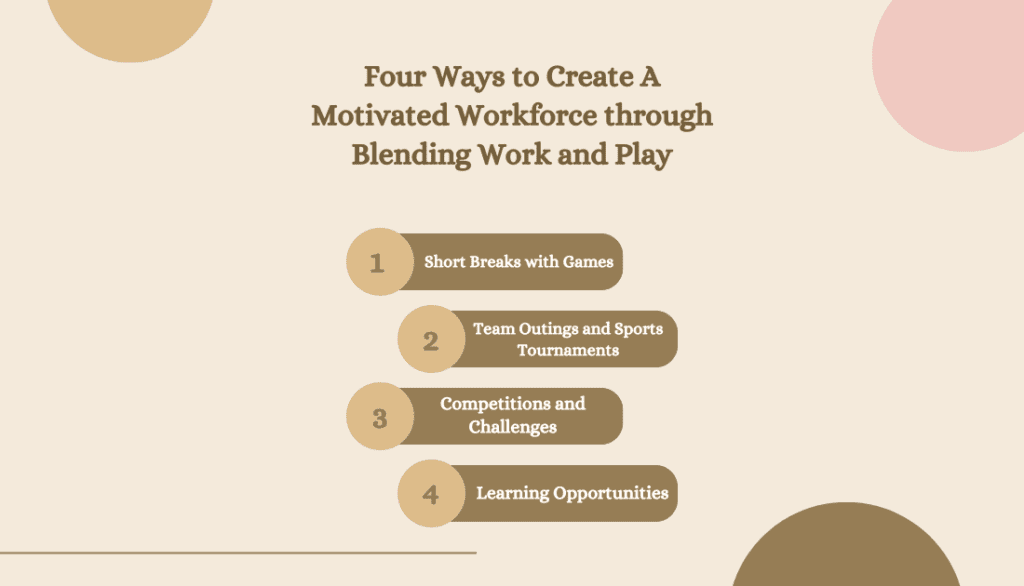



Consider the following four ways to achieve this:
- Short Breaks with Games: Allow employees to take short breaks where they can enjoy activities like playing board games or video games.
- Team Outings and Sports Tournaments: Encourage team outings and organize sports tournaments to foster colleague bonding.
- Competitions and Challenges: Conduct monthly team competitions or challenges to revitalize the work atmosphere and boost productivity.
- Learning Opportunities: Plan seminars, workshops, or webinars where employees can learn new skills with colleagues or external experts.
Creating a Motivated Workforce can also include offering unique learning opportunities, such as studying French with Lingoda. By providing access to high-quality language training, you enrich your employees’ professional skills and personal development.
This not only enhances their engagement but opens up new avenues for communication and interaction within a global business environment.
Know The Impact Of Engagement
Research demonstrates the importance of employee engagement, as indicated by the SHRM 2021-2022 Job Satisfaction and Engagement survey. The survey revealed that various factors contribute to engagement, including positive relationships with coworkers (79%), the meaningfulness of the job (75%), utilization of skills and abilities (74%), and contribution to business goals (76%).
Leaders must prioritize improving these aspects to enhance employee engagement.
Invest in Professional Development
Providing professional growth and learning opportunities is a powerful way to engage employees. By offering training programs, workshops, and skill-building initiatives, employers demonstrate their commitment to their employees’ development.
This investment enhances individual capabilities and contributes to overall organizational success.
Offer Competitive Compensation
Competitive pay rates are crucial for attracting and retaining talented individuals. Employees who feel their compensation aligns with their contributions are likelier to stay engaged and motivated.
Reviewing and adjusting compensation packages to match industry standards helps create a sense of fairness and appreciation among employees.
Partnering with an executive compensation consulting firm can ensure these packages are not only competitive but also strategically designed to boost employee engagement and motivation.
Provide Rewards And Incentives
Recognizing outstanding work and rewarding achievements can significantly boost employee morale and engagement. Implementing a structured recognition program that acknowledges and rewards exceptional performance fosters a positive work environment.
This can include monetary incentives, public appreciation, or career advancement opportunities.
Introduce Open Communication
Introducing a culture of open communication is essential for maintaining employee engagement. Encouraging transparent dialogue across all levels of the organization allows employees to share their ideas, concerns, and feedback without fear of repercussions.
Regular check-ins and feedback sessions provide opportunities for continuous improvement and help employees feel valued and heard.
Encourage Creativity and Innovation
Creating an environment that fosters creativity and innovation promotes employee engagement. Encourage teams to think outside the box, share ideas, and explore new approaches to problem-solving.
Providing resources and support for innovative initiatives empowers employees and strengthens their connection to their work.
Build Trust and Collaboration
Building trust within the organization is crucial for employee engagement. Employees should feel comfortable expressing their opinions, ideas, and concerns without fear of negative consequences.
This atmosphere of trust promotes collaboration and teamwork, leading to increased job satisfaction and overall engagement.
Recognize One’s Worth
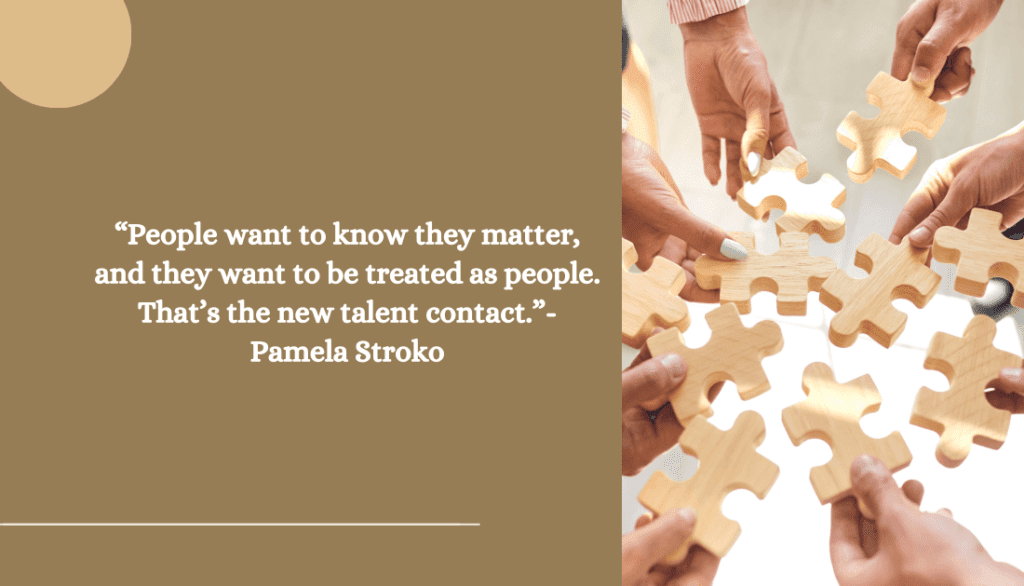



Recognizing and appreciating the unique strengths and weaknesses of each employee is essential. Tailoring solutions and assignments according to individual capabilities enhances engagement by ensuring employees work in roles that align with their strengths.
“People want to know they matter, and they want to be treated as people. That’s the new talent contact.”- Pamela Stroko
Acknowledging and valuing employees’ qualities inside and outside the workplace demonstrates a genuine appreciation for their contributions.
To achieve success, organizations must prioritize employee engagement. Investing in professional development, offering competitive compensation, and providing rewards and recognition.
Additionally, fostering open communication, encouraging creativity & innovation, cultivating trust, and valuing individual differences. By following these factors, leaders can create an environment that promotes employee engagement.
These strategies contribute to a motivated and dedicated workforce, improving performance and overall organizational success.
How to Keep Employees Engaged Using Onethread
Onethread is a powerful catalyst for boosting employee engagement. By leveraging its features and capabilities, Onethread creates an environment that fosters collaboration, communication, and empowerment, ultimately enhancing employee engagement. Here’s how Onethread achieves this:
- Seamless Collaboration: Onethread provides a centralized platform for team members to collaborate effortlessly. With features like real-time messaging, task assignments, and file sharing, employees can work together, share ideas, and contribute actively, fostering a sense of teamwork and engagement.
- Transparent Communication: Clear and transparent communication is essential for employee engagement. Onethread ensures that important project updates, discussions, and decisions are visible to all team members. This transparency eliminates silos, encourages open communication, and empowers employees to stay informed and engaged.
- Empowerment through Task Management: Onethread’s task management feature empowers employees by assigning them responsibilities, deadlines, and priorities. Clear task assignments and progress tracking give employees a sense of ownership and accountability, leading to increased engagement and motivation.
- Recognition and Feedback: Onethread facilitates recognition and feedback through features like comments and notifications. Team members can acknowledge each other’s achievements, offer feedback, and provide support, fostering a positive work culture that boosts employee morale and engagement.
- Enhanced Visibility and Inclusion: Onethread’s visibility into project progress, timelines, and workload ensures that all team members know about ongoing activities. This inclusivity promotes collaboration, encourages involvement, and helps employees feel valued as part of the bigger picture, leading to higher engagement.
With its collaborative features, transparent communication, empowerment through task management, recognition and feedback mechanisms, and enhanced visibility, Onethread is pivotal in improving employee engagement. So give Onethread a try and start improving your employee engagement today!
Final Words
So, you have learned about how to keep employees engaged at work? As an employer, it’s important to take the time to ensure your employees are engaged and happy in their work. Small steps can go a long way toward improving employee engagement and morale.
Encouraging open communication, providing meaningful feedback, offering rewards for good performance, and allowing flexible working arrangements are all great ways to help keep employees engaged with their work.
With this kind of effort, you’ll be able to create a workplace where everyone feels appreciated and motivated to do their best!
Transform your company culture with Onethread! Discover the power of seamless collaboration and effective project management.
Frequently Asked Questions
How Can I Measure Employee Engagement?
You can measure employee engagement through surveys, interviews, focus groups, and tracking work performance. Ask employees how satisfied they are with their job and what changes they want. Monitor their progress to assess if any improvements have been made.
What Is The Best Way To Provide Feedback To Employees?
Provide feedback that is timely, consistent, and specific. Make sure the feedback is clear and actionable. Use a supportive tone to help them grow and stay engaged.
How Can I Get Employees to Take Ownership of Their Work?
Encourage employees to take pride in their work. Ask them how they would do things differently and allow them to try their ideas. Offer recognition when they come up with creative solutions.
What Are The Advantages of Having Highly Engaged Employees?
Having highly engaged employees brings many advantages. They are more productive, take initiative, and show commitment to their work. This leads to increased job satisfaction, decreased turnover rates, and better overall results for the company.
